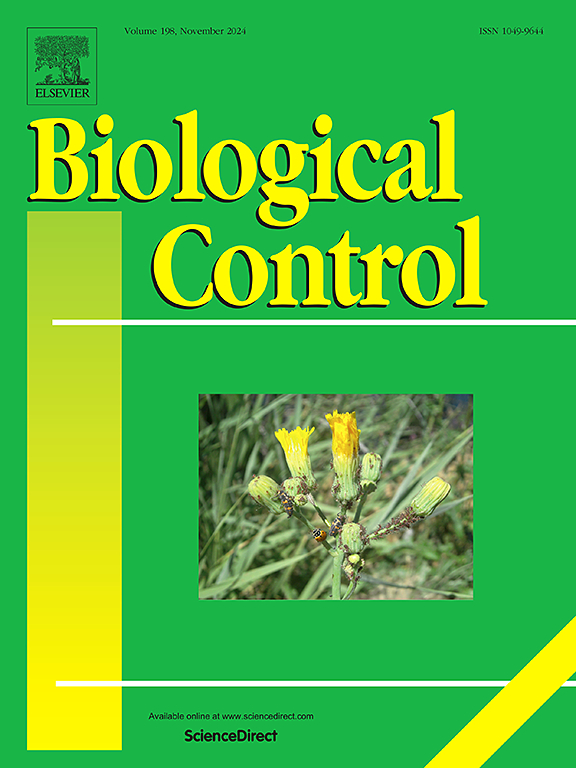由两种链霉菌制成的叶面喷雾剂抑制油菜籽上的菌核菌茎腐病,并抑制其他真菌病原体
IF 3.4
2区 农林科学
Q2 BIOTECHNOLOGY & APPLIED MICROBIOLOGY
引用次数: 0
摘要
从小麦根中分离得到的一株放线菌对油菜枯萎病病原菌的抑制作用进行了体外和植株筛选,并鉴定出两株有效的广谱链霉菌。这些菌株的抗真菌活性完全抑制了菌核菌的体外生长,无论是用琼脂平板竞争试验还是用液体培养的培养滤液进行测试。在平板实验中,这两种菌株也抑制了油菜病原菌黄斑细粒绦虫和索拉尼根丝核菌的生长。显微镜研究发现,链霉菌菌株在油菜幼苗的根和叶组织中定植。在以幼苗为基础的研究中,当作为叶面喷雾剂施用时,两种菌株的培养物或培养滤液可防止菌核菌叶片病变的发展。在成熟植物的温室盆栽研究中,叶面喷洒培养物或培养滤液可显著减少菌核病茎损伤和菌核发育,培养滤液提供更高水平的疾病控制。在两个开花期进行双重喷洒时,与未处理的对照相比,施用培养滤液的植株茎损伤或菌核发育分别减少了87 - 99%和100%;这相当于商业化学杀菌剂控制提供的疾病保护。这些处理的粮食产量比未加保护的菌核菌感染的对照提高了30 - 49%。本研究鉴定的两种链霉菌菌株及其培养滤液具有生物防治应用潜力,可维持或提高作物生产力,减少农业系统对化学疾病防治的需求。本文章由计算机程序翻译,如有差异,请以英文原文为准。
A foliar spray made from two Streptomyces spp suppresses Sclerotinia stem rot on canola and inhibits other fungal pathogens
An Actinobacteria collection isolated from wheat roots for Fusarium crown rot disease control was screened in vitro and on planta for suppression of fungal pathogens of canola and identified two potent broad-spectrum Streptomyces species strains. Antifungal activity from these strains completely inhibited in vitro growth of Sclerotinia sclerotiorum, both when tested using agar plate competition assays or using culture filtrates derived from liquid cultures. Both strains also inhibited growth of the canola pathogens Leptosphaeria maculans and Rhizoctonia solani in plate assays. Microscopy studies found the Streptomyces sp. strains colonised root and leaf tissues of canola seedlings. In seedling-based studies when applied as a foliar spray, cultures or culture filtrates from both strains prevented development of Sclerotinia leaf lesions. In a mature plant glasshouse pot study, foliar spraying of the cultures or culture filtrates significantly decreased Sclerotinia stem lesion and sclerotia development, with culture filtrates providing a higher level of disease control. In dual sprays applied at two flowering stages, an 87–99 % and 100 % reduction of stem lesions or sclerotia development respectively were recorded on plants sprayed with culture filtrate compared to untreated controls; this was equivalent to disease protection provided by a commercial chemical fungicide control. Grain yields in those treatments increased by 30–49 % relative to controls infected with Sclerotinia without protection. The two Streptomyces sp. strains and their culture filtrates identified in this study have potential for biocontrol applications that maintain or improve crop productivity, reducing the need for chemical disease control in agricultural systems.
求助全文
通过发布文献求助,成功后即可免费获取论文全文。
去求助
来源期刊

Biological Control
生物-昆虫学
CiteScore
7.40
自引率
7.10%
发文量
220
审稿时长
63 days
期刊介绍:
Biological control is an environmentally sound and effective means of reducing or mitigating pests and pest effects through the use of natural enemies. The aim of Biological Control is to promote this science and technology through publication of original research articles and reviews of research and theory. The journal devotes a section to reports on biotechnologies dealing with the elucidation and use of genes or gene products for the enhancement of biological control agents.
The journal encompasses biological control of viral, microbial, nematode, insect, mite, weed, and vertebrate pests in agriculture, aquatic, forest, natural resource, stored product, and urban environments. Biological control of arthropod pests of human and domestic animals is also included. Ecological, molecular, and biotechnological approaches to the understanding of biological control are welcome.
 求助内容:
求助内容: 应助结果提醒方式:
应助结果提醒方式:


